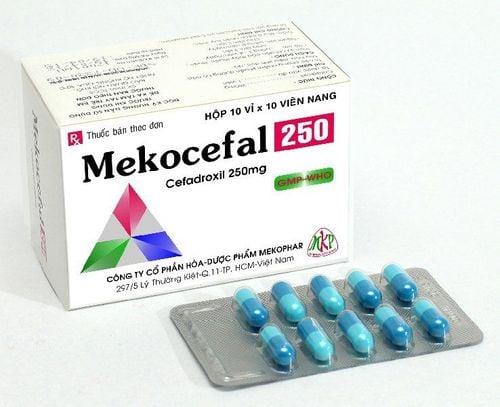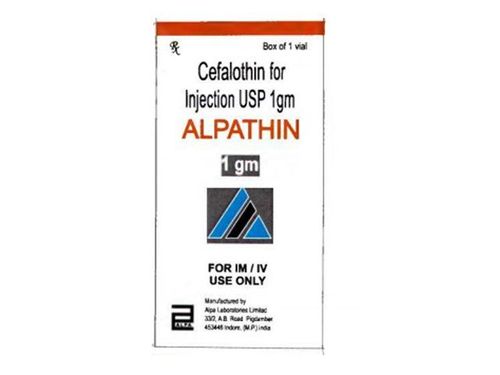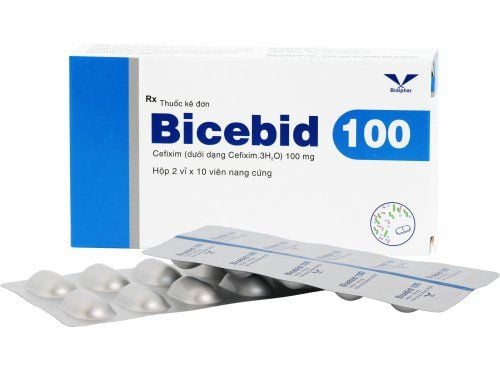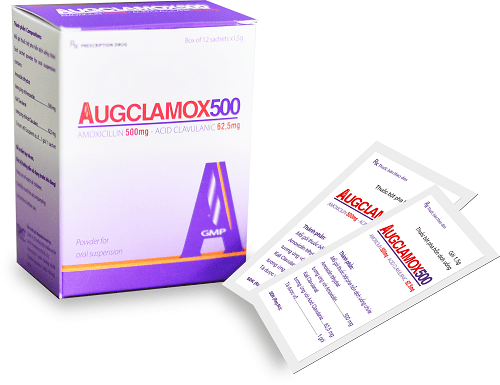This is an automatically translated article.
Cefalvidi drug belongs to the group of antibiotics, antivirals, antifungals containing the main ingredient is Cefadroxil. Cefalvidi is commonly used to treat urinary, respiratory, skin and soft tissue infections or osteomyelitis, arthritis.
1. What is Cefalvidi?
Cefalvidi drug contains the main ingredient is Cefadroxil, belongs to the first generation Cephalosporin antibiotic group with medium spectrum of activity, effective against gram-positive bacteria such as staphylococcus, streptococcus, pneumococcus (except Methicillin-resistant streptococcus). The drug is also effective against some gram-negative bacteria such as E.coli, Klebsiella pneumoniae, Proteus mirabilis and shigella. The mechanism of action of Cefadroxil is to inhibit bacterial cell wall synthesis, kill bacteria by inhibiting the final stage of bacterial cell wall synthesis, causing bacteria without a protective wall to be destroyed. However, there are strains of bacteria that can be resistant to Cefadroxil such as Enterococcus, Methicillin-resistant Staphylococcus, Proteus with positive indole reaction, Enterobacter, Pseudomonas aeruginosa, Bacteroid.
Regarding the pharmacokinetics, Cefalvidi drug is rapidly and completely absorbed orally, independent of food. The drug is widely distributed in body tissues and fluids, reaching very high concentrations in tissues because of its good solubility in fat. The drug is eliminated mainly unchanged in the urine after 24 hours.
Cefalvidi drug is usually indicated in the following cases:
Urinary tract infections: Acute/chronic pyelonephritis, cystitis, urethritis. Respiratory tract infections: tonsillitis, pharyngitis, bronchitis, lobar pneumonia, pleurisy, empyema, laryngitis, otitis media. Skin and soft tissue infections: lymphadenitis, abscess, cellulitis, ulcer. Osteomyelitis, septic arthritis. Cefalvidi is contraindicated in patients with hypersensitivity to Cephalosporin antibiotics or any of its ingredients.
2. Dosage of Cefalvidi
Depending on the subjects and treatment goals, the dose of Cefalvidi will be different, specifically as follows:
Adults: 500 - 1000mg/time, take 1-2 times/day depending on the degree of infection . Children > 6 years old: 500mg x 2 times/day. Children from 1-6 years old: 250mg x 2 times/day. Patients with renal impairment: Cefadroxil may be initiated at a dose of 500 - 1000 mg but then adjusted according to creatinine clearance. ClCr 0-10ml/min: Use a maintenance dose of 500mg, every 36 hours. ClCr 10-25ml/min: 500mg maintenance dose, every 24 hours. ClCr 25-50ml/min: Use a maintenance dose of 500mg, every 12 hours.
3. Side effects of the drug Cefalvidi
In some patients when using Cefalvidi drug may experience side effects such as:
Nausea, vomiting, abdominal pain, diarrhea. Eosinophilia increased. Skin rash, exanthema, urticaria, pruritus. Reversible increase in transaminases. Testicular pain, vaginitis, candidiasis, genital itching. Rare: Anaphylactic reactions, serum sickness, fever, neutropenia, thrombocytopenia, hemolytic anemia, positive coombs test. Erythema multiforme, Stevens-Johnson syndrome, toxic epidermal necrolysis, angioedema. Cholestatic jaundice, increased liver enzymes. Nephrotoxicity with temporary increase in blood urea and creatinine, reversible interstitial nephritis. Convulsions, headache, agitation. Athritis. When experiencing undesirable effects, Cefalvidi should be discontinued immediately, if severe hypersensitivity reactions require supportive treatment (maintenance of ventilation and use of adrenaline, oxygen, antihistamines, intravenous corticosteroids). Mild cases of pseudomembranous colitis usually only need to stop the drug, if it is moderate and severe, it is necessary to add fluids, electrolytes, protein and take Metronidazol.
4. Precautions when using Cefalvidi
Some general notes when using Cefalvidi drugs include:
Caution when using Cefalvidi in patients allergic to penicillin antibiotics, patients with renal failure, gastrointestinal disease. Long-term use of Cefadroxil can cause overgrowth of non-susceptible bacteria, need to be carefully monitored, if superinfection must stop using the drug. Concomitant administration of Cefalvidi with potassium-sparing diuretics, potassium supplements or salt substitutes containing potassium may lead to increased serum potassium. Cholestyramine binding to Cefadroxil in the intestine may slow the absorption of the drug. Taking Cefadroxil with Probenecid may decrease the excretion of Cefadroxil. Concomitant use of Cefadroxil with Furosemide, Aminoglycosides may synergistically increase nephrotoxicity. Above is all information about Cefalvidi drug, patients need to carefully read the instructions for use, consult a doctor / pharmacist before using. Note, Cefalvidi is a prescription drug, patients need to use the drug as prescribed by the doctor, absolutely do not self-treat at home.













